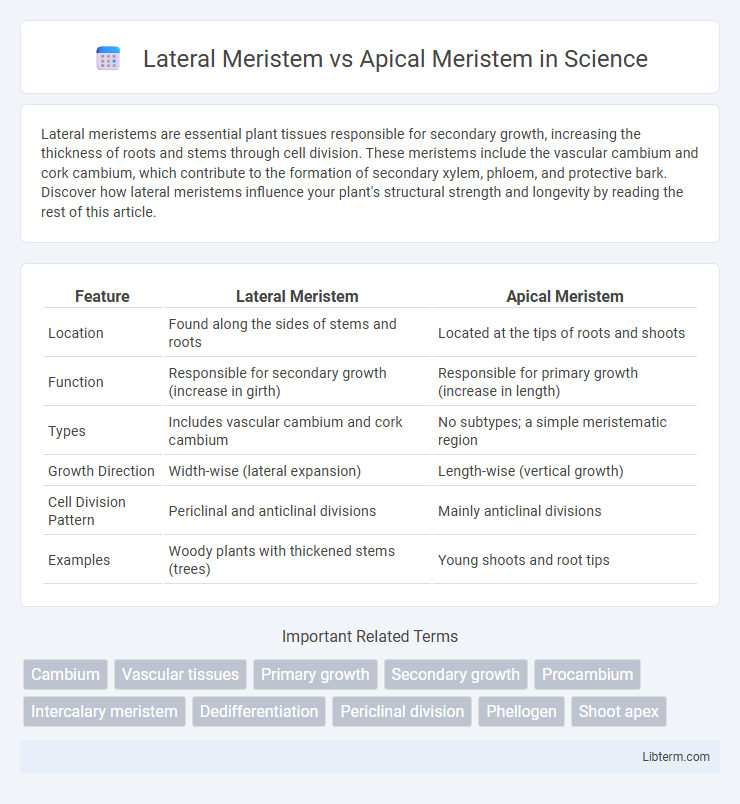Lateral meristems are essential plant tissues responsible for secondary growth, increasing the thickness of roots and stems through cell division. These meristems include the vascular cambium and cork cambium, which contribute to the formation of secondary xylem, phloem, and protective bark. Discover how lateral meristems influence your plant's structural strength and longevity by reading the rest of this article.
Table of Comparison
| Feature | Lateral Meristem | Apical Meristem |
|---|---|---|
| Location | Found along the sides of stems and roots | Located at the tips of roots and shoots |
| Function | Responsible for secondary growth (increase in girth) | Responsible for primary growth (increase in length) |
| Types | Includes vascular cambium and cork cambium | No subtypes; a simple meristematic region |
| Growth Direction | Width-wise (lateral expansion) | Length-wise (vertical growth) |
| Cell Division Pattern | Periclinal and anticlinal divisions | Mainly anticlinal divisions |
| Examples | Woody plants with thickened stems (trees) | Young shoots and root tips |
Introduction to Plant Meristems
Plant meristems are specialized tissues responsible for continuous growth and development in plants. Apical meristems are located at the tips of roots and shoots, driving primary growth and elongation, while lateral meristems, found along the sides of stems and roots, contribute to secondary growth by increasing girth. These meristematic tissues contain undifferentiated cells capable of division, enabling plants to adapt and expand throughout their life cycle.
Definition of Lateral Meristem
Lateral meristem is a type of plant tissue responsible for secondary growth, increasing the girth of stems and roots by producing new cells laterally. Unlike apical meristem, which contributes to primary growth at the tips of roots and shoots, lateral meristem includes vascular cambium and cork cambium that enable thickening of the plant body. This secondary growth is essential for the development of woody plants and the formation of bark and secondary vascular tissues.
Definition of Apical Meristem
The apical meristem is a region of actively dividing cells located at the tips of roots and shoots, responsible for primary growth and elongation of the plant. In contrast, the lateral meristem, found along the sides of stems and roots, facilitates secondary growth, increasing the girth of the plant. Apical meristems produce new tissues that contribute to height and root extension essential for nutrient absorption and photosynthesis.
Location and Structure of Lateral Meristem
Lateral meristem is located along the sides of stems and roots, responsible for secondary growth, increasing the thickness of the plant. It consists mainly of the vascular cambium and cork cambium, which produce secondary vascular tissues and protective outer layers, respectively. Unlike the apical meristem found at root and shoot tips that drives primary growth, lateral meristem cells are cylindrical and arranged in a continuous ring to facilitate radial expansion.
Location and Structure of Apical Meristem
The apical meristem is located at the tips of roots and shoots, driving primary growth by producing new cells that elongate the plant body. Structurally, it consists of small, densely packed, actively dividing cells with thin walls and a large nucleus to facilitate continuous cell division. In contrast, the lateral meristem is found along the sides of stems and roots, responsible for secondary growth that increases thickness.
Functions of Lateral Meristem
Lateral meristem plays a crucial role in secondary growth by producing vascular tissues like xylem and phloem, which increase the girth of stems and roots. It is responsible for the thickening of plant organs, enabling them to support larger structures and transport nutrients efficiently. Unlike apical meristem that contributes to primary growth and lengthening, lateral meristem sustains the plant's radial growth and overall structural strength.
Functions of Apical Meristem
Apical meristem plays a crucial role in primary growth by facilitating elongation of roots and shoots, allowing plants to increase in height and depth. This dynamic tissue produces new cells for the formation of organs such as leaves and flowers. Unlike lateral meristem, which is responsible for secondary growth and thickness, apical meristem drives vertical growth and the development of new structures essential for photosynthesis and reproduction.
Key Differences Between Lateral and Apical Meristems
Lateral meristems, such as the vascular cambium and cork cambium, are responsible for secondary growth, increasing the thickness of stems and roots, whereas apical meristems contribute to primary growth by elongating shoots and roots. Apical meristems are located at the tips of roots and shoots, producing new cells that extend plant length, while lateral meristems are found along the sides of stems and roots, facilitating girth expansion. The primary function of apical meristems is vertical growth and formation of primary tissues, contrasting with lateral meristems' role in producing secondary tissues and enhancing structural support.
Importance in Plant Growth and Development
Lateral meristems, including the vascular cambium and cork cambium, are crucial for secondary growth, increasing the girth and structural support of woody plants. Apical meristems located at the root and shoot tips drive primary growth, enabling elongation and the formation of new organs such as leaves and flowers. The combined activity of lateral and apical meristems ensures both height expansion and thickening, essential for overall plant development and adaptation.
Conclusion: Lateral Meristem vs Apical Meristem
Lateral meristem enables secondary growth by increasing the girth of stems and roots, while apical meristem drives primary growth, elongating the plant vertically. The distinct roles of lateral and apical meristems facilitate both structural support and height expansion, essential for overall plant development. Understanding the functional differences highlights their complementary contributions to plant morphology and adaptation.
Lateral Meristem Infographic

 libterm.com
libterm.com